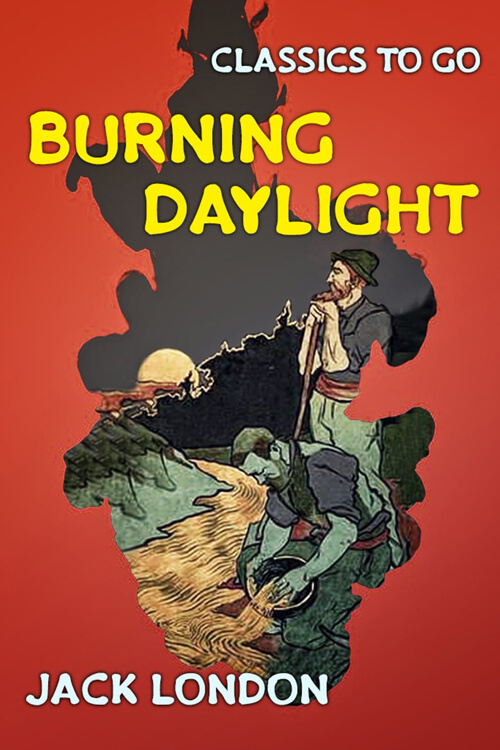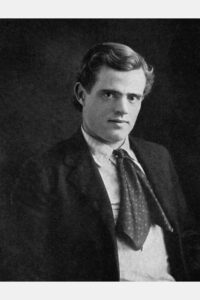
Burning Daylight
It was a quiet night in the Shovel. At the bar, which ranged along one side of the large chinked log room, leaned half a dozen men, two of whom were discussing the relative merits of spruce tea and lime juice as remedies for scurvy. They argued with an air of depression and with intervals of morose silence. The other men scarcely heeded them. In a row, against the opposite wall, were the gambling games. The crap-table was deserted. One lone man was playing at the faro table. The roulette ball was not even spinning, and the gamekeeper stood by the roaring, red-hot stove, talking with the young, dark-eyed woman, comely of face and figure, who was known from Juneau to Fort Yukon as the Virgin. Three men sat in at stud-poker, but they played with small chips and without enthusiasm, while there were no onlookers. On the floor of the dancing room, which opened out at the rear, three couples were waltzing drearily to the strains of a violin and a piano.
Circle City was not deserted, nor was money tight. The miners were in from Moseyed Creek and the other diggings to the west, the summer washing had been good, and the men’s pouches were heavy with dust and nuggets. The Klondike had not yet been discovered, nor had the miners of the Yukon learned the possibilities of deep digging and wood-firing. No work was done in the winter, and they made a practice of hibernating in large camps like Circle City during the long Arctic night. Time was heavy on their hands, their pouches were well-filled, and the only social diversion to be found was in the saloons. Yet the Shovel was practically deserted, and the Virgin, standing by the stove, yawned with uncovered mouth and said to Charley Bates:—
“If something doesn’t happen soon, I’m gin’ to bed. What’s the matter with the camp, anyway? Everybody dead?”
Bates did not even have trouble to reply but went on moodily rolling a cigarette. Dan MacDonald, pioneer saloonman and gambler on the upper Yukon, owner and proprietor of the Tivoli and all its games, wandered forlornly across the great vacant space of floor and joined the two at the stove.
“Anybody dead?” the Virgin asked him.
Read or download Book
Jack London
John Griffith Chaney (January 12, 1876 – November 22, 1916), better known as Jack London, was an American novelist, journalist and activist. A pioneer of commercial fiction and American magazines, he was among the first American authors to become an international celebrity and earn a large fortune from writing. He was also an innovator in the genre later known as science fiction.
London was part of the radical literary group “The Crowd” in San Francisco and a passionate advocate of animal rights, workers’ rights, and socialism. London wrote several works dealing with these topics, such as his dystopian novel The Iron Heel, his non-fiction exposé The People of the Abyss, War of the Classes, and Before Adam.
His most famous works include The Call of the Wild and White Fang, both set in Alaska and the Yukon during the Klondike Gold Rush, as well as the short stories “To Build a Fire”, “An Odyssey of the North”, and “Love of Life”. He also wrote about the South Pacific in stories such as “The Pearls of Parlay”, and “The Heathen”.
Family
Jack London was born on January 12, 1876. His mother, Flora Wellman, was the fifth and youngest child of Pennsylvania Canal builder Marshall Wellman and his first wife, Eleanor Garrett Jones. Marshall Wellman was descended from Thomas Wellman, an early Puritan settler in the Massachusetts Bay Colony. Flora left Ohio and moved to the Pacific coast when her father remarried after her mother died. In San Francisco, Flora worked as a music teacher and spiritualist, claiming to channel the spirit of a Sauk chief, Black Hawk.
Biographer Clarice Stasz and others believe London’s father was astrologer William Chaney. Flora Wellman was living with Chaney in San Francisco when she became pregnant. Whether Wellman and Chaney were legally married is unknown. Stasz notes that in his memoirs, Chaney refers to London’s mother Flora Wellman as having been “his wife”; he also cites an advertisement in which Flora called herself “Florence Wellman Chaney”.
Late in 1876, Flora Wellman married John London, a partially disabled Civil War veteran, and brought her baby John, later known as Jack, to live with the newly married couple. The family moved around the San Francisco Bay Area before settling in Oakland, where London completed public grade school. The Prentiss family moved with the Londons and remained a stable source of care for the young Jack.
Early life
London was born near Third and Brannan Streets in San Francisco. The house burned down in the fire after the 1906 San Francisco earthquake; the California Historical Society placed a plaque at the site in 1953. Although the family was working class, it was not as impoverished as London’s later accounts claimed. London was largely self-educated. In 1885, London found and read Ouida’s long Victorian novel Signa. He credited this as the seed of his literary success. In 1886, he visited the Oakland Public Library and found a sympathetic librarian, Ina Coolbrith, who encouraged his learning. (She later became California’s first poet laureate and an important figure in the San Francisco literary community).
In 1889, London began working 12 to 18 hours a day at Hickmott’s Cannery. Seeking a way out, he borrowed money from his foster mother Virginia Prentiss, bought the sloop Razzle-Dazzle from an oyster pirate named French Frank, and became an oyster pirate himself. In his memoir, John Barleycorn, he claims also to have stolen French Frank’s mistress Mamie. After a few months, his sloop became damaged beyond repair. London was hired on as a member of the California Fish Patrol.
First success
On July 12, 1897, London (age 21) and his sister’s husband Captain Shepard sailed to join the Klondike Gold Rush. This was the setting for some of his first successful stories. London’s time in the harsh Klondike, however, was detrimental to his health. Like so many other men who were malnourished in the goldfields, London developed scurvy. His gums became swollen, leading to the loss of his four front teeth. A constant gnawing pain affected his hip and leg muscles, and his face was stricken with marks that always reminded him of the struggles he faced in the Klondike. Father William Judge, “The Saint of Dawson”, had a facility in Dawson that provided shelter, food, and any available medicine to London and others. His struggles there inspired London’s short story, “To Build a Fire” (1902, revised in 1908), which many critics assess as his best.
His landlords in Dawson were mining engineers, Marshall Latham Bond and Louis Whitford Bond, educated at the Bachelor’s level at the Sheffield Scientific School at Yale and the Master’s level at Stanford, respectively. The brothers’ father, Judge Hiram Bond, was a wealthy mining investor. While the Bond brothers were at Stanford, Hiram at the suggestion of his brother bought the New Park Estate at Santa Clara as well as a local bank. The Bonds, especially Hiram, were active Republicans. Marshall Bond’s diary mentions friendly sparring with London on political issues as a camp pastime.






